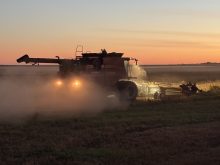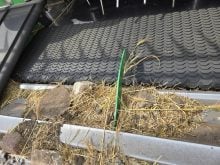It can be an onerous task to stop the combine and check for grain losses every time conditions change, but that’s exactly what operators should do, says Derek Rude of the Prairie Agricultural Machinery Institute.
Rude, who looks closely at the fine line between increasing a combine’s productivity and maintaining acceptable losses, said operators should do this at least until they learn their machine well enough to know exactly what level of loss it produces under various conditions.
“The economics show, in my opinion, that it’s worth the time to stop and check for losses,” he said.
Read Also

Agritechnica Day 2: The future of tractor power, building quicker crop apps and large farms and tech
Agritechnica Day 2: The future of tractor power, building quicker crop apps with Syngenta and large farms and tech
“We promote the use of loss pans. We think they are as accurate as you can get.
Rude said operators should turn off the chopper and spreader when using catch pans, or use more pans on the left and right sides of the machine if they have to leave them engaged.
“When you first start out checking losses, it’s a little misleading because of the small amount of grain in the pan, but sometimes that little amount is a high bushel per acre loss,” he said.
“So we really encourage you to quantify that loss with a scale.”
PAMI makes a combine scale loss guide available online. As well, card calculators and apps for smartphones will translate the losses captured in catch pans into losses per acre and economic losses if producers know their operating costs.
Rude used the example of a quarter section of canola where canola is worth $10 per bu. The combine, with a 40 foot header, has a one bu. per acre loss at three m.p.h. and three bu. per acre at four m.p.h.
The faster combine speed saves the operator 3.2 hours.
He tallied the operational cost of the combine at $300 per hour, which he said would be roughly the total cost of a newer combine, including fuel, capital purchase and labor.
“So, your loss in dollars per hour at three m.p.h. is $145 an hour,” he said.
“At four m.p.h., it’s actually $585 an hour. So by going that extra mile an hour, you’ve increased your loss by $440 per hour. So for that quarter section of land, it actually cost you $2,360 to go that one m.p.h. faster,” Rude said.
He said there are other issues to consider as well, including maintaining a grain grade, not only on this field but also on the other fields. However, he said the example gives operators something to think about when they are setting the combine and ground speed.
Rude said PAMI aims for a one bu. per acre loss, but there are other conditions, such as significantly dry canola, where a two bu. per acre loss may be as good as an operator can realistically hope to obtain while maintaining a reasonable speed.
For more combine setting resources visit http://pami.ca/index-2/.
Small losses can add up over time
Canadian farmers harvest grain from 72 million acres each year.
Losing only one or two bushels of grain may seem like an acceptable loss, but it translates into hundreds of millions of dollars.
Most producers don’t have a common answer for what constitutes an acceptable loss on their farm because it will change from day to day, field to field and crop to crop.
For example, if unfavourable weather is on the way, it might make economic sense to speed up and incur more losses than would normally be acceptable because farmers could lose a grade on the crop if they don’t get it in sooner.
Producers have to know the cost of the losses they are accruing before they can calculate a level of loss that makes economic sense on their farm.
Misconceptions about combine productivity and harvesting losses
We asked Derek Rude, project manager at the Prairie Agricultural Machinery Institute, about the top myths that persist about productivity and loss. Here’s what he had to say:
Myth 1 – A combine’s productivity should be measured by how many miles per hour it can travel when harvesting.
Rude said a lot of context is missing when combine productivity is thought of in that way.
“There is header width, height to your crop, how high you’re cutting, what the yield is. There are many other variables to factor into the performance of the combine instead of just speed.”
Instead, producers should pay attention to the amount of material other than grain (MOG) that goes through their combines.
“You have to get the grain out of that MOG, so if yield increases, it doesn’t mean your combine all of the sudden has lost capacity. You’re still getting a certain bushel per hour in productivity, so that’s what’s important.”
Myth 2 – More power in a combine creates more productivity.
“In some cases, power may be a limiting factor, but in a lot of cases it isn’t. In a lot of cases, there’s separation limits and feeding limits,” Rude said.
“If you’re using all of that horsepower through the whole season in every crop and in every condition, you’ll be losing grain at some point.”
Rude said the potential for losses is getting higher because of the increased horsepower in new combines.
Myth 3 – Keeping the machine full equals higher capacity.
Rude said that is true only at significantly low feed rates and ground speeds. He said the loss curve tends to be flat until MOG is increased to the point where the separator and cleaning shoe’s capacity is surpassed and grain is being carried out with the straw and chaff.
“At that point, loss goes up exponentially,” he said. “So the idea there are benefits to keeping the machine fuller and driving faster are not necessarily true.”
Myth 4 – Combine losses can’t be that bad.
Rude said just because a combine cost half a million dollars and its yield monitor isn’t detecting significant losses doesn’t mean they are not happening.
Myth 5 – The losses are OK if producers can’t find significant losses on the ground.
New choppers and spreaders can spread over 40 feet, which can make it difficult to find the losses, especially with smaller seeds such as canola.
Myth 6 – A combine can go the same speed with a larger header.
“Capacity is all about feed rate,” Rude said.
“If you’re going the same speed with a narrow header and you go to a wider header, it doesn’t magically gain capacity in your combine.”
Myth 7 – The same settings for one crop are fine for the entire season.
“Our conditions vary so widely even from the morning to the afternoon and back to the evening again, you should be adjusting your settings when your conditions change.”
Myth 8 – The loss monitor accurately measures losses.
Rude said producers need to ground truth what the monitor indicates. It is a relative measure.
“So how much does three bars mean? It might mean three bushels per acre, it might mean half a bu. per acre. You don’t know. So it’s really just an indicator,” he said.
“In our opinion, they’re not really feeding you much for information you can adjust your combine by.”
















